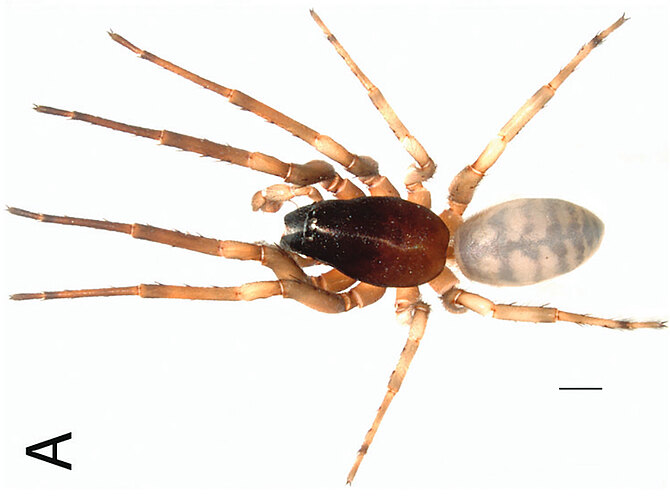Kangaroo Island Tube-web Spider Ariadna clavata Marsh, Baehr, Glatz & Framenau, 2018
Fauna Portal species: 8908Diagnosis
(after Marsh et al. 2018): Males and females of A. clavata are distinguished from A. segmentata by the curvature of the posterior eye row, which is strongly procurved in A. segmentata and which is slightly recurved in A. clavata. Males of A. clavata differ from A. segmentata by the long, curved and distally hooked embolus, while the embolus of A. segmentata is shorter and stouter. The pedipalp bulb of A. clavata differs from that of A. muscosa by being roughly pyramidal in shape, while that of A. muscosa is spheroidal. Males and females of A. clavata differ from A. muscosa by the number of teeth on the tarsal claws of the first legs; A. muscosa has 7 or 8 teeth, with the inferior claw bare, A. clavata has 10 or 11 teeth, with a small tooth on the inferior claw). Females of A. clavata differ from A. burchelli by the number of teeth on the chelicerae; A. burchelli has one tooth either side of the fang furrow, A. clavata has three teeth on the promargin, one tooth on the retromargin. Ariadna clavata differs from all remaining Australian Ariadna by the presence of transverse abdominal markings.
Status
- native
Linnean Holotype
Australia
- South Australia
Fauna Portal Records
The map shows all records that have been verified as part of the Fauna Portal project and may not represent the true distribution of a species. Specifically, for described species, check the link to the Atlas of Living Australia on this page for potential wider distributions. Fauna Portal Reference specimens and Linnean types are shown in red. If you identified a specimen that exceeds the distribution of an undescribed species as illustrated here, please contact the Fauna Portal team who can assist with the lodgement of the specimen in a public institution and display on the map.
Publications
Araneae (Spiders)
- Actinopodidae
- Anamidae
- Araneae fam. indet.
- Araneidae
- Archaeidae
- Argyronetidae
- Arkyidae
- Barychelidae
- Cheiracanthiidae
- Clubionidae
- Corinnidae
- Cycloctenidae
- Deinopidae
- Desidae
- Dictynidae
- Filistatidae
- Gnaphosidae
- Halonoproctidae
- Hersiliidae
- Idiopidae
- Lamponidae
- Linyphiidae
- Lycosidae
- Mimetidae
- Miturgidae
- Mysmenidae
- Nicodamidae
- Oecobiidae
- Oonopidae
- Oxyopidae
- Philodromidae
- Pholcidae
- Pisauridae
- Prodidomidae
- Salticidae
- Scytodidae
- Segestriidae
- Selenopidae
- Sparassidae
- Symphytognathidae
- Tetrablemmidae
- Tetragnathidae
- Theridiidae
- Thomisidae
- Trachelidae
- Trachycosmidae
- Trochanteriidae
- Uloboridae
- Zodariidae
- Zoropsidae
All classes
- Arachnida
- Crustacea
- Entognatha
- Gastropoda
- Insecta
- Orthoptera - Caelifera (Grasshoppers)
- Hymenoptera excl. Formicidae (bees and wasps)
- Blattodea s. str. (Cockroaches)
- Coleoptera (Beetles)
- Dermaptera (earwigs)
- Diptera (flies, mosquitos)
- Entomobryomorpha (slender springtails)
- Hemiptera - Heteroptera (True Bugs)
- Hemiptera - Sternorrhyncha (aphids, scales etc.)
- Hemiptera - Auchenorrhyncha (cicadas, planthoppers)
- Hymenoptera - Formicidae (Ants)
- Trichoptera (Caddisflies)
- Zygentoma (silverfish)
- Myriapoda

